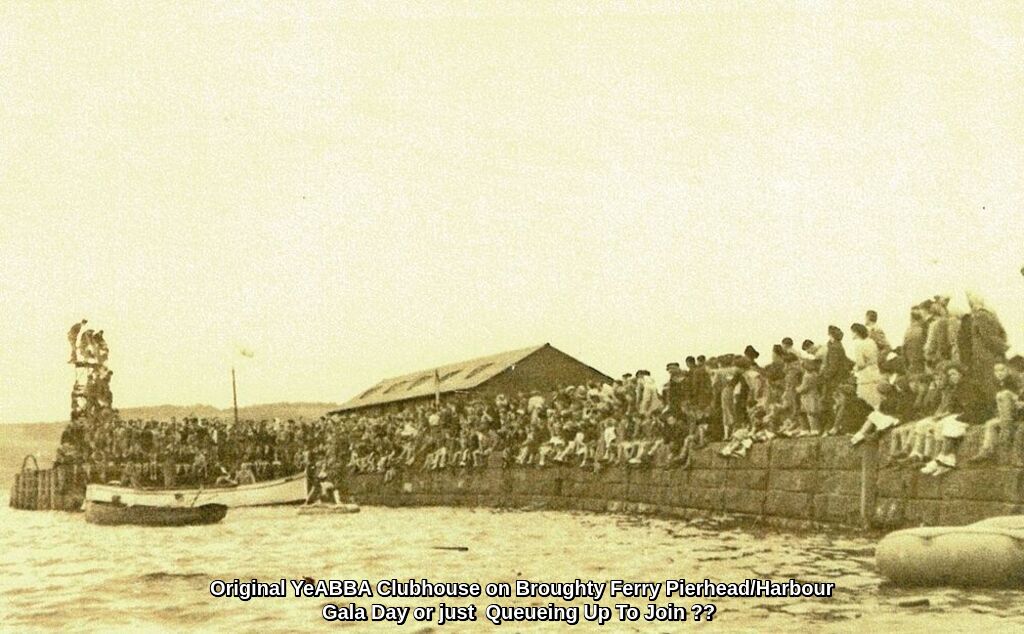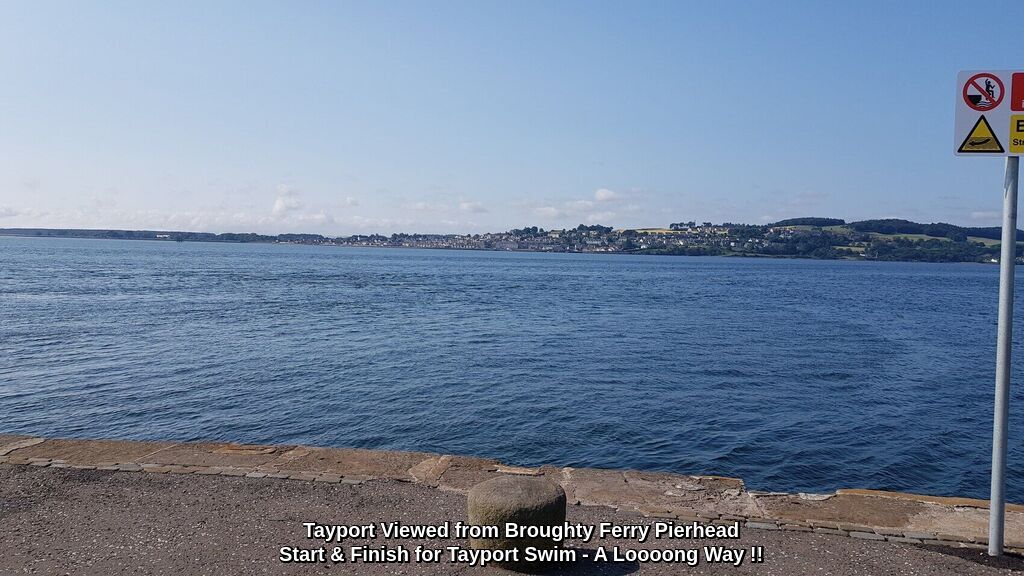Open Water Swimming – History and Development in Scotland
Swimmers from a number of Scottish clubs have participated in Long Distance Swimming events over the years since the late 19th century.
Notable among these is Ye Amphibious Ancients Bathing Association (YeABBA), which is the only club in Scotland that has been and currently is primarily Long Distance/Open Water based.
The club’s focus on this branch of the sport has provided a foundation for the development in Scotland as a whole.
YeABBA has have been in existence in Broughty Ferry since 1884, when the Club’s original premises were opened on the Broughty Pier.
In the early years, it was nothing for 60 or more swimmers to appear on a morning for their regular “dook”, always providing the steamer was not docking at the time!
The club’s pioneers achieved a number of credible firsts, including in 1899, when John Shaw and Bob Macmillan made the first crossing of the River Tay.
Bill Blair claimed the first double when he swam over and back in 1905 and Miss Topsy Johnson, became the first lady to make the crossing in 1906 in 42mins 34 secs. Seventy years on and the Double-Double was achieved by William Bennett.
The Club’s swimmers were also to conquer Scotland’s premier Lochs, Ness and Lomond as well as Loch Tay, Rannoch, Tummel, Earn, and in England, Windermere, Ullswater, Coniston, Morecambe and Torbay, to mention a few. Even the Suez Canal was to see the “Phibbies” in pursuit of their sport.
During the 1900s, a number of other Clubs organized local “Long Distance/Open Water” Events, usually in the cleaner parts of river estuaries. Clydebank ASC had the “Medical” Trophy, with the Events swum in the Clyde at Helensburgh. Gourock ASC had a similar competition in the Clyde estuary waters around Gourock.
The positive environment for Open Water swimming that YeABBA and some other clubs set was “picked up” and supported by the SASA from the mid-1980s National Championships were formulated which have attracted growing numbers of participants.
Recognition by FINA , the sport’s governing body, led to World and European Championships, being held annually at venues worldwide. It also led to a change in concept, putting fresh demands on the swimmers, especially at the top levels of competition.
Despite this, Open Water swimming, within the “competitive swimming” environment was still largely overshadowed by pool swimming and by pool competitions.
By the mid 1990’s, the Scottish Championships composed of a Senior “short course” race at Loch Lubnaig and a “long course” race at Loch Rannoch.
Both of these events were “point to point” races over the length of the lochs, giving them distances of approx. 3¾ miles and 9½ miles respectively. The longer race for the Junior Championships were the Loch Lubnaig course, which was supplemented by a shorter distance event on the Tay and there was a Juvenile event of swimmers under the age of 12, held over 500 metres.
Safety has always been a priority in long distance races, with each swimmer normally being accompanied by their own boat crewed by a pilot and a life saver responsible for the swimmer’s welfare and providing them with drinks on longer swims. Partly as a result of the requirement for so many boats, it was difficult to attract large numbers and participation was mostly among swimmers from the Dundee area. However, involvement became more widespread in the latter part of the 1990’s. A North District Championship was established in 1997, followed by the East District a year later. The West District Championship was established around 2003.
Open Water events started to attract swimmers who had performed well at 800 and 1500 metres in the pool and Scotland sent representatives to the FINA World event in London in 2000, gaining two places in the top 8, while a gold medal was won in the World Masters Championships in the same year.
The most significant development of the early 2000’s was the creation of a National Development Squad. Letters were written to the top distance swimmers encouraging them to take part in Open Water events in the 2002 season. From the seasons results, 15 swimmers were selected to make up the Squad which trained over three weekends at the National Swimming Academy in Stirling, in preparation for the 2003 season. The squad system continued for a number of years with the aim of competing in domestic competitions across Scotland and England and a short tour in Europe taking in a few regional level events. Based on results from the season, a smaller team was selected to represent Scotland at an International event. Success followed in the coming years with a few highlights being;
- Selection of a number of swimmers to represent Britain including James Leitch competing in the World Championships.
- Scottish Swimmers winning 5 of the 6 events at the 2003 ASA Age-Group Championships
- Susan Black winning the 25km French Open Championships in 2004.
- Scottish swimmers taking all podium places in the ASA Women’s 5 km Championships in 2005.
- Scottish swimmers taking all podium places in the French Women’s 5 km Championships, also in 2005.
Since then, Scottish teams have competed abroad on many occasions returning with numerous trophies from events on the continent. One of the most notable achievements being Mark Deans’ win in the German 25 km championships of 2013.
The other main area of development was to make significant changes to the format of domestic events. The traditional point to point format was popular in that it represented the challenge of completing a course from one location to another, typically the opposite ends of a loch. However, this presented difficulties in safely catering for the increasing numbers. The solution was to move most events to circuit races whereby competitors swam round a number of loops of a course marked by buoys. This kept everyone with easy reach of the fast rescue craft and swimmers could then be monitored by a number of canoeists.
While safety had always been a priority, there was a lack of guidance as to what was appropriate in organizing and running event. The National Open Water Committee set about establishing and documenting requirements for events in Scotland, including on the water rescue craft and on land medical facilities. Safety provision was one of the corner stones for the licencing system introduced a few years later.
A further development in the organization of domestic events was the creation of a recognized Training and Qualification Scheme for officials. This was established around 2004 and one of the officials who qualified in the initial group went on to officiate at the 10 km Races when Open Water was reintroduced to the Olympics in 2008.
Most events in the Scottish Championships from 2003 onwards were held at Lochore Meadows in Fife, the longest event, the 9½ mile Loch Rannoch race continued until 2010. In 2011 all events were brought together when the Championships were held over 2 days at Loch Tay. By this time there was a settled programme of events of 2 km, 5 km and 10 km. The numbers participating had grown making it sensible to divide up the previous Junior category into two Age Groups: 13-14 and 15-16 years. With the number of older swimmers taking part also increasing, separate Masters Categories were also introduced. At the Scottish Championships these were 10 year age bands; 25-34 years, 35-44 years, 45-55 years and 55+ years while at district events an age adjusted handicapping system was introduced.
A year later, 2012, the Championships moved Loch Venachar, where they remained until 2019. Some changes in the format have included a shorter race over 500 metres for swimmers aged 10-12 and team events in various formats.
Over the last 20 years, the District Championships have evolved and the YeAABA events continued to provide for the traditional Point to Point races. These combined to provide a calendar of events over the period June-September. Selected events in the Scottish and District Championships formed Senior and Junior Grand Prix Competitions, whereby points were allocated based on position and the top five swimmers in each category were awarded cash prizes. In later years a Grand Prix for Club Relay Teams was introduced.
Interest in Open Water Swimming, in its various forms, has grown over the last 30 years (to 2021) as a recreational pursuit, albeit with participants wearing wetsuits, and with many enjoying wild swimming as opposed to competition. In the early 2000’s, it was recognized by the National Open Water Committee that this could be a route for attracting many more to take part in swimming events in a similar way in which people from a wide range of abilities participate in distance running events. The problem was that events organised by Scottish Swimming couldn’t accept entries from swimmers who weren’t members of SASA affiliated clubs. Suggestions were made for a scheme whereby swimmers pay a small additional fee to become temporary members for the day of the event. For a number of years this was opposed, but eventually the constitution was amended to allow Open Water and Masters disciplines to include for Temporary Members. However, by that time, commercial organisations had captured the market with mass participation events such as the Great British Swim series, which included an annual event at Loch Lomond.
In recent years’ the most significant change has been in the use of wetsuits. Until 2016, while a few introductory events were held with swimmers in wetsuits, they weren’t acceptable within the rules for the championship events at national or district level. However, a change in FINA rules had a knock-on effect to national regulations meaning that the use of wetsuits became compulsory below 18°C and optional between 18°C and 20°C. Given the temperatures experienced in Scotland, this effectively turned the domestic sport into a wetsuit activity. Feelings on this were mixed, while it attracted some new swimmers to the discipline, the break with tradition was considered unnecessary by others. Paradoxically, the same period has seen an increase in the sport of ice/winter swimming in which competitors swim in temperatures below 5°C and without wetsuits.
While competitive Open Water swimming has much less participation than its counterpart in the pool, its popularity is increasing and will hopefully continue to grow and become accepted by more Scottish clubs as part of the activities they offer their members.


